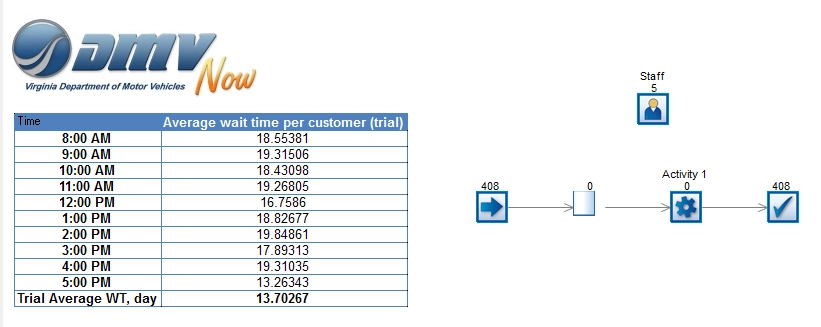Virginia DMV uses simulation to reduce customer wait times

- Industry
- Public sector
- Location
- Virginia, U.S.
- Goals
- Identify how to cope with future demand while still delivering customer satisfaction.
Achievements with Simul8
-
-
Projected staffing levels needed to achieve an average wait time of 20 minutes or less statewide
-
-
A better understanding of customer arrival patterns on weekdays versus weekend
-
-
Clarity on the impact of customer overflow from one hour to the next on wait times
About the project
The Virginia Department of Motor Vehicles (DMV) serves over 4.5 million customers per year across 74 customer service centers, with an average volume of between 11,000 and 155,000 customers per center.
Conducting licensing, vehicle, and identification related transactions, as well as offering services on behalf of other government agencies, the Virginia DMV has an extensive footprint across the US Commonwealth of Virginia. The agency’s service strategy is to offer the same level of service throughout the Commonwealth to all its residents.
With a 2015 customer survey identifying that one-third of customers did not believe that wait time expectations were met, the Virginia DMV wanted to devise a more efficient staffing model that would potentially achieve an average wait time of 20 minutes or less.
With driver’s license renewals projected to increase by more than 700 percent in FY2017, improved performance in this area was vital to coping with future demand while still delivering customer satisfaction.
As part of Virginia DMV’s data-driven decision making, Simul8's simulation software provided recommended staffing levels across the 74 customer service centers, based on arrival patterns and service demand, to achieve the service goal. The recommendations also provided agency executives with the ability to make decisions in pursuit of the ideal balance of customer satisfaction and operational efficiency.


"Simulation offers a unique tool to simultaneously consider multiple factors and estimate all future customer wait times. As a result, our capacity has improved to plan around trends and future initiatives."
Senior Policy Analyst, Virginia Department Of Motor Vehicles

How was simulation used to identify staffing needs?
Customer wait time prior to being served is a key performance measure used at the Virginia DMV.
Customer service center wait times are impacted by a wide range of factors including hourly customer volume, staffing and scheduling, transaction type, service time, and geographical location. As such, consideration of all of these factors was essential in creating accurate staffing recommendations.
Simul8's simulation software provided DMV with a powerful tool capable of mapping this customer flow within each customer service center. This enabled analysis of all variables simultaneously and significantly improved the quality of analysis.
A simulation model was developed in Simul8 utilizing existing queuing system data from the most recent fiscal year to calculate service type probability, average service time by service type, and average hourly customer arrivals. Resources were defined using aggregated serve time from the current queuing system and then adjusted for shrinkage to determine hourly staffing levels.
DMV conducted an initial trial run with hourly customer arrivals being adjusted until the model’s wait time for each customer service center fell into an acceptable range.
Once normalized, the wait time benchmark was set and the full model was run, using an algorithm designed to identify the lowest number of staff required to accomplish an average wait time at each hour interval.
For each trial, 100 runs were calculated to produce hourly average wait times. The scenario was evaluated chronologically, and at the earliest instance where the average wait time exceeded the benchmark, the staff resource was increased by one.
Further trials were automatically conducted until staffing levels accomplished the wait time benchmark for a full day of operation. Upon completion, recommendations were evaluated against existing limitations such as maximum staff available and service window availability.
For example, if the model returned a staffing recommendation of 25 in the third hour, but only 12 service windows are available at the site, the staffing numbers were manually reduced to reflect that limitation.
Another trial was completed after manual adjustments were made. If the average wait time met the 20 minute goal, recommended staffing levels were compared to the actual staffing levels, and the variance was reported as the staffing adjustment necessary for each hourly interval to achieve the benchmark.



"Analytically, our methods are more robust and the perspective gained by using simulation has been well-received by the agency."
Senior Policy Analyst, Virginia Department Of Motor Vehicles

A powerful tool to optimize staffing and improve customer satisfaction
With this model, the Virginia DMV now has at its disposal a powerful tool capable of identifying appropriate levels of staff needed on the front counter to serve customers on an hourly basis to achieve and maintain wait times of 20 minutes or less.
Not only has Simul8’s simulation software assisted Virginia DMV in its efforts to improve wait times and customer satisfaction, it has also provided broader opportunities to utilize service data and identify potential metrics for future use.
Throughout the iterative simulation process, a number of unintended benefits were realized including:
- Greater understanding of data including arrival patterns on weekdays versus weekend and the extent to which transaction times differ based on service type.
- Increased clarity on the impact of customer overflow from one hour to the next on waiting times.
- Understanding the experience of each individual customer service center over the course of a day.
- Analyze customer patterns to provide recommendations for policy decisions that will positively impact future customer service.
Learn more about Simul8 for process improvement
Find out more about how simulation is used by organizations, read more case studies and access a range of learning resources.
Learn more